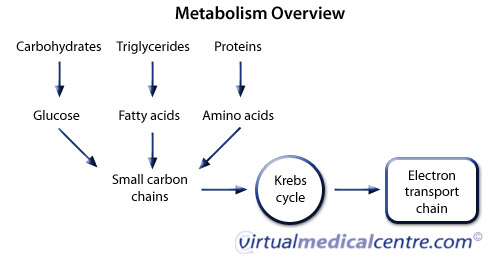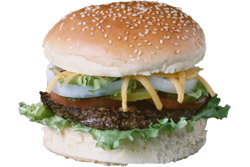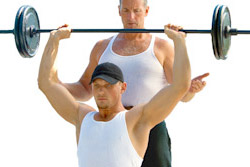- What is metabolism?
- Energy sources
- Aerobic metabolism
- Carbohydrate metabolism
- Lipid metabolism
- Protein metabolism
- Weight loss implications
What is metabolism?

Metabolism therefore produces energy to perform all the functions of different tissues within the body. Metabolism works by breaking down foods in the diet or compounds in the body into their smaller components. These can then enter into special reactions to produce ATP. The left over components are recycled by the body and used to regenerate the original compounds.
Energy sources

- Carbohydrates: These are the sugar type compounds in the body. Carbohydrates come from foods such as bread, cereal, potatoes, fruits and sugar-containing foods or bevarages. When carbohydrates are digested in the gastrointestinal system they are broken down into smaller molecules such as glucose (a simple sugar). The main storage sites for carbohydrates in the body are the liver and muscles.
- Lipids: This basically refers to fats (such as cholesterol) from the diet or stored in adipose tissue (in other words the body fat). Lipids are broken down into smaller components called fatty acids for energy. Therefore lipids are really just chains of fatty acids joined together.
- Proteins: These make up nearly three quarters of all the solid materials in the body. Proteins are thus the basic structural components in the body. They are made up of smaller agents called amino acids – considered the building blocks of proteins. Protein is present in the diet in foods such as meat, eggs, nuts and dairy products.
In general, carbohydrates form the main energy source for the body. They are the most efficient at producing ATP or energy (meaning they produce lots more ATP per amount of the fuel broken down). The body preferentially breaks down carbohydrates first, and then fats and finally proteins only if the other two fuels are depleted. This is important as proteins are generally less efficient at generating energy. In addition, proteins perform several important functions so if they were broken down several systems could fail.
To illustrate an example, in the event of starvation, the body has fewer carbohydrates available so will start to breakdown the fat stores in the body. Once all the available carbohydrate and fat stores have been depleted, the body will start to break down proteins to provide energy.
The diagram below provides a summary of the body’s main energy sources. These get broken down by enzymes into smaller particles. These small carbon chains can then enter into special pathways to generate energy (discussed below).

Aerobic metabolism
Aerobic metabolism refers to metabolic processes that occur in the presence of oxygen. Oxygen acts as an oxidising agent in the combustion of the various fuels. Special reactions occur which finally lead to oxygen accepting electrons (small negatively charged particles). This causes energy to be released and ATP to be produced. The waste products are water and carbon dioxide which can be easily excreted from the body. Carbohydrates are the main fuel used for aerobic metabolism.
In the absence of oxygen certain reactions are not possible. A different process occurs involving pyruvic acid which also leads to the production of ATP. These mechanisms allow cells to survive a few extra minutes when they are deprived of oxygen. Anaerobic metabolism causes lactic acid to build up. In addition it is a less efficient way of producing energy. Less ATP is produced per molecule of original fuel.
Carbohydrate metabolism

The glycogen is broken down to reproduce glucose. Glucose undergoes a series of reactions to finally produce ATP. These reactions rely on an adequate supply of oxygen and glucose. If oxygen is lacking glucose can still be broken down by a different set of reactions as described above. However if glucose is lacking the body will turn to other fuel sources for energy.
Glucose metabolism involves the following steps:
- Glycolysis: This basically refers to the breakdown of glucose into an agent called pyruvic acid. A couple of molecules of ATP are produced by this reaction.
- Krebs cycle: Pyruvic acid enters into the Kreb cycle by being converted to acetyl-CoA. This is again a series of reactions that leads to the breakdown of the fuels into carbon dioxide and water. This generates more useable energy. The original compound is regenerated so the cycle can continue. The Krebs cycle occurs in the mitochondria of cells. These are small oval shaped, double membrane, little organs of cells which act as the cell’s power stations.
- Oxidative phosphorylation: During the Krebs cycle a lot of potential energy is transferred as electrons to another compound called NAD. This is broken down in the electron transport chain. A chain of reactions occurs where electrons are passed along to the next compound in line. The final agent to accept electrons is oxygen. This process generates a lot of energy which is converted into ATP.
Lipid metabolism
Lipids are basically the fats in the body which include cholesterol, triglycerides and phospholipids. The main components of these are fatty acids which are released when the lipids are broken down. Fatty acids are absorbed through the intestine and are taken up via the lymphatic system. Fats can be utilised for energy or may be stored as adipose tissue. The metabolism of lipids involves the following processes:
- Lipolysis: This refers to the breakdown of the fats into their fatty acid and other components. Some of these agents can enter directly into the Krebs cycle for oxidation. Triglycerides get broken down into fatty acids and glycerol. The latter is converted into pyruvic acid which can enter the Krebs cycle.
- Beta-oxidation: This refers to the breakdown of fatty acids within the mitochondria. ATP is generated from this process as well as acetyl-CoA which can enter the Krebs cycle and produce more energy.
Lipid metabolism is efficient in terms of ATP production. However, lipids aren’t soluble in the blood so their stores can be difficult to access. Therefore they aren’t relied on for the production of large amounts of ATP in a short time but rather are used when carbohydrate supplies are limited.
Ketosis refers to an increased concentration of ketone bodies within the blood. The most common ketone produced is acetic acid. It is caused by metabolism of predominantly fats in the absence of sufficient carbohydrate metabolism. It is thus a feature of starvation, diabetes mellitus (as insulin is not available to transport glucose to cells) and occasionally occurs when diets consist almost entirely of fat.
When carbohydrates are unavailable for energy the body switches to metabolism of fatty acids. The body takes these from adipose tissue (the body’s fat stores). The fatty acids generated can either be broken down for energy or may be converted to ketone bodies within the liver. Some ketones can be excreted in the breath and give it a sweet smell (acetone breath).
Protein metabolism

The correct balance of amino acids is needed so that all important proteins can be synthesised. When proteins are digested, the bonds between amino acids are broken and they are released. Normally the amino acids will be recycled and used to produce new proteins. However if energy sources are limited, the amino acids may be used to generate energy. This should only occur when carbohydrate and fat energy stores are depleted as proteins make up several important structures in the body. If they are extensively metabolised it may interfere with the function of tissues.
The following processes occur in protein metabolism:
- Deamination: The first step in breaking down amino acids is removal of the amino group (the part of the amino acid structure containing nitrogen and hydrogen). Ammonia is generated by this process which is converted to urea by the liver. Urea can then be excreted in the urine. The amino acid is converted to a compound called a ketoacid which can enter the Krebs cycle.
- Oxidation of amino acids: This refers to the breakdown of ketoacids and generation of ATP, similar to acetyl-CoA in carbohydrate and lipid metabolism. The amount of ATP produced from protein metabolism is slightly less than glucose metabolism for equivalent weights.
Weight loss implications
Several diets use the above principals of metabolism to generate weight loss. To lose weight your body must burn more calories (through exercise) than it takes in from the diet. Some diets limit the overall number of calories which obviously will cause weight loss as the body’s energy stores will be utilised. Other diets work by trying to alter the normal balance between carbohydrate, lipid and protein metabolism. Remember that the body burns carbohydrates first, followed by fats and proteins only when the other two are depleted. Therefore if the carbohydrates in the diet are limited, the body will start to burn fat stores. Low calorie diets (LCD), and meal replacement programs such as the Tony Ferguson diet work exactly by this mechanism.
Article kindly reviewed by:
The DAA WA Oncology Interest Group
and
Food4Health (Helen Baker Dietitian-APD)
More information
 |
For more information on fitness and exercise, including stretches, types of exercise, exercise recovery and exercise with health conditions, as well as some useful videos, see Fitness and Exercise. |
 |
For more information on nutrition, including information on types and composition of food, nutrition and people, conditions related to nutrition, and diets and recipes, as well as some useful videos and tools, see Nutrition. |
 |
For more information on obesity, health and social issues, and methods of weight loss, as well as some useful tools, see Obesity and Weight Loss. |
References
- Fine EJ, Feinman RD. Thermodynamics of weight loss diets. Nutr Metab (Lond). 2004;1(1):15. [Abstract | Full text]
- Guyton AC, Hall JE. Textbook of Medical Physiology (10th edition). Edinburgh: WB Saunders Company; 2000. [Book]
- Johnson L. Essential Medical Physiology (2nd edition). Philadelphia, PA: Lippincott Williams and Wilkins; 1998. [Book]
- Martini F, Ober WC. Fundamentals of Anatomy and Physiology (5th edition). New Jersey, NJ: Prentice-Halll; 2001. [Book]
All content and media on the HealthEngine Blog is created and published online for informational purposes only. It is not intended to be a substitute for professional medical advice and should not be relied on as health or personal advice. Always seek the guidance of your doctor or other qualified health professional with any questions you may have regarding your health or a medical condition. Never disregard the advice of a medical professional, or delay in seeking it because of something you have read on this Website. If you think you may have a medical emergency, call your doctor, go to the nearest hospital emergency department, or call the emergency services immediately.







